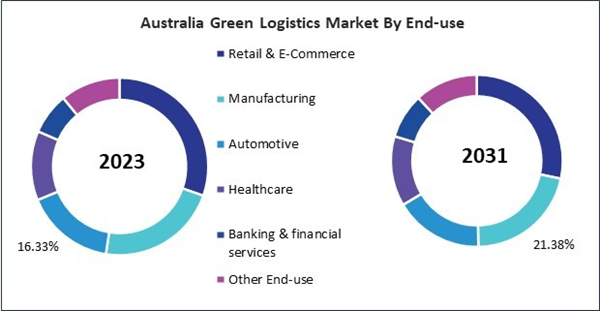The Asia Pacific Green Logistics Market is expected to witness market growth of 8.3% CAGR during the forecast period (2024-2031).
The China market dominated the Asia Pacific Green Logistics Market by country in 2023, and is expected to continue to be a dominant market till 2031; thereby, achieving a market value of $263.48 billion by 2031. The Japan market is experiencing a CAGR of 7.7% during 2024-2031. Additionally, the India market is expected to exhibit a CAGR of 9% during 2024-2031.
Collaborative logistics networks and regulatory initiatives further support adopting circular supply chain models. Companies like DHL and UPS are implementing reusable packaging systems, consolidated shipping, and carbon-neutral shipping options to optimize resource utilization and lower emissions. While challenges like high initial costs and supply chain complexity exist, technological advancements, digital tracking, and regulatory support drive a shift toward sustainable logistics solutions. As more industries embrace circular logistics, businesses reduce costs and environmental impact and gain a competitive advantage in the evolving economy.
As urbanization accelerates, cities adopt sustainable urban freight solutions to combat congestion and emissions. Micro-mobility options, such as e-bikes, cargo bikes, and electric scooters, are increasingly used for short-distance deliveries. Companies like DHL, FedEx, Uber Eats, and Amazon are integrating e-bike fleets to optimize last-mile logistics. DHL’s electric cargo bikes reduce carbon emissions by up to 60% per delivery.
Singapore's strategic position and dedication to smart logistics solutions are making it a regional leader in sustainable logistics. The Sustainable Logistics Framework, developed under the Green Plan 2030, promotes using autonomous electric freight vehicles, urban micro-mobility solutions, and AI-powered inventory systems. The Tuas Mega Port, designed to be one of the world’s most sustainable ports, integrates solar energy, automated cranes, and AI-driven ship route optimization to minimize carbon emissions. Companies like DB Schenker and DHL are heavily investing in green warehousing and sustainable supply chain technologies to align with Singapore’s eco-friendly logistics vision. Thus, green logistics will continue to influence supply chain management in Asia Pacific as e-commerce, urbanization, and climate change legislation grow.
The China market dominated the Asia Pacific Green Logistics Market by country in 2023, and is expected to continue to be a dominant market till 2031; thereby, achieving a market value of $263.48 billion by 2031. The Japan market is experiencing a CAGR of 7.7% during 2024-2031. Additionally, the India market is expected to exhibit a CAGR of 9% during 2024-2031.
Collaborative logistics networks and regulatory initiatives further support adopting circular supply chain models. Companies like DHL and UPS are implementing reusable packaging systems, consolidated shipping, and carbon-neutral shipping options to optimize resource utilization and lower emissions. While challenges like high initial costs and supply chain complexity exist, technological advancements, digital tracking, and regulatory support drive a shift toward sustainable logistics solutions. As more industries embrace circular logistics, businesses reduce costs and environmental impact and gain a competitive advantage in the evolving economy.
As urbanization accelerates, cities adopt sustainable urban freight solutions to combat congestion and emissions. Micro-mobility options, such as e-bikes, cargo bikes, and electric scooters, are increasingly used for short-distance deliveries. Companies like DHL, FedEx, Uber Eats, and Amazon are integrating e-bike fleets to optimize last-mile logistics. DHL’s electric cargo bikes reduce carbon emissions by up to 60% per delivery.
Singapore's strategic position and dedication to smart logistics solutions are making it a regional leader in sustainable logistics. The Sustainable Logistics Framework, developed under the Green Plan 2030, promotes using autonomous electric freight vehicles, urban micro-mobility solutions, and AI-powered inventory systems. The Tuas Mega Port, designed to be one of the world’s most sustainable ports, integrates solar energy, automated cranes, and AI-driven ship route optimization to minimize carbon emissions. Companies like DB Schenker and DHL are heavily investing in green warehousing and sustainable supply chain technologies to align with Singapore’s eco-friendly logistics vision. Thus, green logistics will continue to influence supply chain management in Asia Pacific as e-commerce, urbanization, and climate change legislation grow.
List of Key Companies Profiled
- United Parcel Service, Inc.
- C.H. Robinson Worldwide, Inc.
- Deutsche Bahn AG (DB Schenker)
- Yusen Logistics Co., Ltd. (Nippon Yusen Kabushiki Kaisha)
- XPO, Inc.
- Kuehne + Nagel International AG (Kuehne Holding AG)
- FedEx Corporation
- DSV A/S
- Deutsche Post DHL Group (The Deutsche Post AG)
- A.P. Moller-Maersk A/S
Market Report Segmentation
By Mode of Transportation
- Roadways
- Railways
- Waterways
- Airways
By Business Type
- Warehousing
- Distribution
- Value added services
By End-use
- Retail & E-Commerce
- Manufacturing
- Automotive
- Healthcare
- Banking & financial services
- Other End-use
By Country
- China
- Japan
- India
- South Korea
- Australia
- Malaysia
- Rest of Asia Pacific
Table of Contents
Chapter 1. Market Scope & Methodology
Chapter 2. Market at a Glance
Chapter 3. Market Overview
Chapter 5. Asia Pacific Green Logistics Market by Mode of Transportation
Chapter 6. Asia Pacific Green Logistics Market by Business Type
Chapter 7. Asia Pacific Green Logistics Market by End-use
Chapter 8. Asia Pacific Green Logistics Market by Country
Chapter 9. Company Profiles
Companies Mentioned
- United Parcel Service, Inc.
- C.H. Robinson Worldwide, Inc.
- Deutsche Bahn AG (DB Schenker)
- Yusen Logistics Co., Ltd. (Nippon Yusen Kabushiki Kaisha)
- XPO, Inc.
- Kuehne + Nagel International AG (Kuehne Holding AG)
- FedEx Corporation
- DSV A/S
- Deutsche Post DHL Group (The Deutsche Post AG)
- A.P. Moller - Maersk A/S
Methodology

LOADING...









